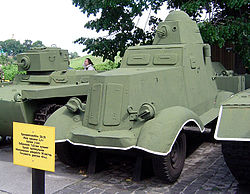| BA-20 | |
|---|---|
 | |
| Type | Armored car |
| Place of origin | |
| Service history | |
| In service | 1936-1945 |
| Used by | |
| Wars | Spanish Civil War Soviet–Japanese border conflicts Winter War World War II |
| Production history | |
| No. built | 2,066 |
| Specifications | |
| Mass | 2.27 tonnes |
| Length | 4.31 m (14 ft 2 in) |
| Width | 1.74 m (5 ft 9 in) |
| Height | 2.13 m (7 ft 0 in) |
| Crew | 2-3 |
| Armor | 6-9 mm |
Main armament | 7.62 mm DT machine gun [1] |
| Engine | GAZ-M1 50 hp (37 kW) |
| Power/weight | 20 hp/tonne |
| Suspension | wheeled |
Operational range | 350 km (220 mi) |
| Maximum speed | 80 km/h (50 mph) [2] |
The BA-20 (Russian : Broneavtomobil 20) was an armored car developed in the Soviet Union in 1934. [3] It was intended to replace the FAI and its field trials were completed in 1935. [4] The BA-20 was then used in the early stages of World War II.

